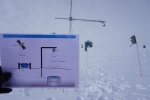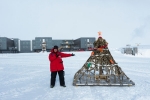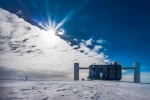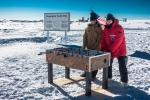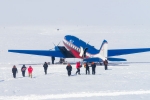Last week’s photos sum up the main activities for IceCube folks currently at the South Pole—snowmobiling, shoveling, and sunbathing.
Wait a minute—seals? penguins? at the South Pole? Well, you’re right to wonder, because the climate at the South Pole, in central Antarctica, is too harsh for survival even for animals adapted to lower temperatures. But winterovers deserve a break from Pole life when possible, and IceCube winterover Martin made it to McMurdo station last week for a few days of R&R, where he was able to capture penguins, seals, and a skua—all in the same shot.
A relatively quiet week at the Pole … but sunny! IceCube winterover Martin captured a bright, radiating sun as it appeared to rest on the roof of the IceCube Lab (ICL). Sunny or not, no flights made it in or out last week, postponing Martin’s week of R&R that had been scheduled.
The year’s end doesn’t mean an end to the work going on at the Pole. Last week, continued detector upgrades and some inventory tasks were on the work roster. There was also considerable progress made on a new IceTop snow-depth sensor project, documented in this image.
Last week, Christmas was celebrated in many parts of the world, and that includes the South Pole. They had a makeshift “cargo” tree, presents for the winterovers, a fancy dinner—complete with a printed menu and assorted European desserts, and a party in the gym.
It might be cold, but it’s summer at the South Pole, and the sun was out in full force, captured in this image of the IceCube Lab (ICL) with a striking mass of clouds cutting a swath through the sky
A busy week at the South Pole, but not too busy for fun and games. Last week they held a foosball tournament at the geographic pole. In fact, it apparently was the first international southernmost foosball tournament, period. And IceCube winterover Martin was one of the winners. Yay, team!
Not many people have the opportunity to go to the South Pole. Its remoteness and extreme climate make traveling there complicated, and access to the South Pole station and other research facilities at the Pole is restricted or limited at best.





